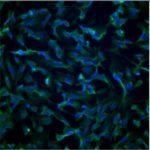Link to Pubmed [PMID] – 16598074
Nucleic Acids Res. 2006;34(6):1900-11
Human topoisomerase II (topo II) is the cellular target for a number of widely used antitumor agents, such as etoposide (VP16). These agents ‘poison’ the enzyme and induce it to generate DNA breaks that are lethal to the cell. Topo II-targeted drugs show a limited sequence preference, triggering double-stranded breaks throughout the genome. Circumstantial evidence strongly suggests that some of these breaks induce chromosomal translocations that lead to specific types of leukaemia (called treatment-related or secondary leukaemia). Therefore, efforts are ongoing to decrease these secondary effects. An interesting option is to increase the sequence-specificity of topo II-targeted drugs by attaching them to triplex-forming oligonucleotides (TFO) that bind to DNA in a highly sequence-specific manner. Here five derivatives of VP16 were attached to TFOs. The active topo II poisons, once linked, induced cleavage 13-14 bp from the triplex end where the drug was attached. The use of triple-helical DNA structures offers an efficient strategy for targeting topo II-mediated cleavage to DNA specific sequences. Finally, drug-TFO conjugates are useful tools to investigate the mechanistic details of topo II poisoning.

